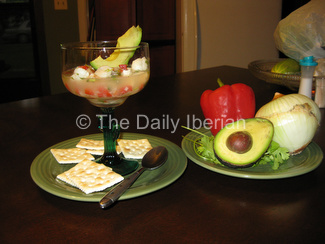Costa Rican cuisine
Published 8:36 am Thursday, July 10, 2014

- A Costa Rican Mixed Ceviche prepared by Deiver Vargas and his son, Oscar, is a tasty appetizer that is a favorite of Costa Ricans.
JEANERETTE — When Oscar Vargas and his father, Deiver Vargas, spend some quality time together, they can often be found in the kitchen of their Jeanerette home cooking some of their favorite Costa Rican cuisine from their native country.
Oscar Vargas, 18, a senior at Jeanerette Senior High School, describes Cost Ricans as emotional cooks who are just as passionate about their food as most Cajuns.
Trending
“Food is a big part of our culture, but unlike Cajuns, we use very little spices in our food and prefer to let the flavors of the food come together. Everything is cooked with fresh ingredients,” he said.
“Our food is what American food was 40 or 50 years ago. Everything is homemade with fresh ingredients. We don’t use box or frozen foods.”
Oscar Vargas was 7 years old when he left Costa Rico to move to Plano, Texas, with his family. It was then he began to experience American cuisine. But his real food culture shock came when he moved to Jeanerette last summer with his father and brother and was introduced to Cajun food.
The Jeanerette teen said he is still learning more about Cajun cuisine from his stepmother, Monica Vargas, and is continually being introduced to new Cajun dishes. In turn, she is learning to prepare some of the dishes that are staples and favorites of the Costa Ricans.
“What Cajuns think of as flavor, to us it is spicy and hot. Costa Rican dishes are not highly seasoned. It is about simplicity. We depend on vegetables such as bell pepper, onions or cilantro to give flavor to the dish,” he said.
“I was about 10 or 11 years old when I started cooking and watching my father preparing simple dishes. I grew up knowing what flavors are good together.”
Trending
Rice is a daily staple of Costa Ricans, with the food menu revolving around it.
“My first American meal I experienced was steak, a baked potato and grilled asparagus. It was delicious, but I was wondering where was the rest of the meal. I had to ask where was the rice,” he said.
Gallo pinto, black beans and rice, are often served as part of the breakfast meal, which is typically the main meal of the day, Deiver Vargas said.
“An ordinary breakfast served in Costa Rico would include gallo pinto, a pork chop and fried or scrambled eggs. The key to cooking a tasty gallo pinto is to cook the rice and beans together to allow the rice to soak up all the flavor of the beans, “ said the 42-year old cook.
The young cook, a member of the Sugar City Growers Co-op, seizes every opportunity to cook with fresh produce and the succulent seafood of the area.
The father and son cooking duo were busy in the kitchen Thursday preparing a ceviche appetizer made with shrimp and freshly picked produce from the Sugar City Co-op hydroponic garden. A combination of shrimp, diced onions, celery, tomatoes and cilantro was marinated in lime juice and chilled for 20 hours before serving. Served in glass stemware and topped with thick slices of avocado, the appetizer is not only appealing to the eye, but tasty.
“It is delicious, but it is something that we didn’t serve often in our country because the shrimp is highly expensive,” he said.





